Ornamental Joy: Alison Aune
Alison Aunes art comes from a feminist aesthetic and an ancient culture. Cheryl Reitan previews her exhibition, Dekorglädje: Swedish Paintings, at the Duluth Art Institute, Oct. 11 -- Jan. 6. Opening reception is Thurs, Oct 18, from 5 7 p.m.
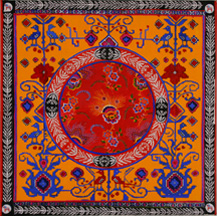
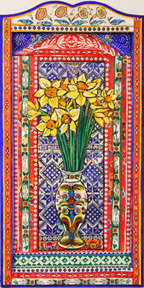
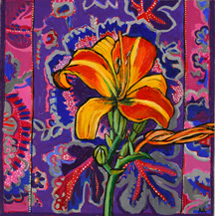
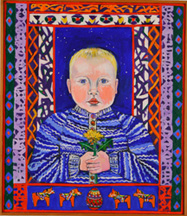

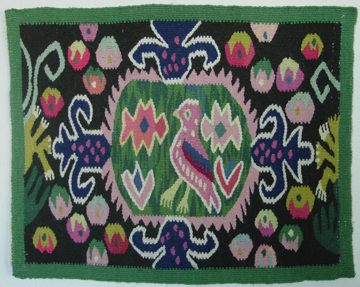
Alison Aune uses the inspiration of Swedish patterns and motifs to reinterpret folk art and keep a tradition alive.
“When I was in art school, nature and decorative art were frowned upon,” she said. “Barbed wire and dead birds were considered serious, nitty-gritty art. That wasn’t me. I paint what I love. This collection honors my mother, as well as Swedish culture, and the art itself gives me the inner strength to buck the trends.” Aune does face opposition. Her work isn’t the postmodern conceptual art that is so often popular with American and Swedish audiences.
Undaunted in her quest for a fresh perspective, Aune traveled to Sweden to collect fabrics and textiles. These patterns formed the stimulus for this new body of work. Currently in Sweden, old textiles have little value. For less than a dollar, she purchased elaborate handmade weavings from an old woman on the street. The patterns hearken back to 18th-century work and Aune saw their potential, not only for her art, but also as anthropological artifacts.
In the States, at IKEA, a store that sells products designed in Sweden, Aune found few products that used traditional Swedish patterns. The ones she found, she purchased and incorporated as mixed media into her paintings. Knackebrod, a large, unleavened circular rye cracker, popular in Sweden, also played a role in her work. Patterns off the elaborately decorated packaging were used repeatedly in the series. One of Aune’s panel paintings, Dalarna Altar, uses a traditional image off the knackebrod package of two country people holding hands. “Knackebrod means Sweden to me,” she said. “It’s peasant food from poor soil of the cold north.”
Aune’s mother, Ilene, whose Swedish background inspired Aune’s interest in the tradition, died of cancer 13 years ago, when Aune was a new mother. One can see strong emotion behind her brush strokes in depictions that refer to this nexus: Swedish ancestors, cancer, and maternity.
Aune says that many of her paintings honor her mother, because they come from a maternal aspect of Swedish culture. The backgrounds in Aune’s paintings were found on clothing, folk costumes, kitchenware, cushions, linens, pillowcases, and other items of domestic adornment found in the Swedish home.
On the surface, Aune’s paintings seems purely decorative. “Dekorglädje” from the title of the exhibition, literally means “decoration happiness.” But as the viewer goes deeper, the layers have meaning. Aune explores the concept of domestic ethnography. Her patterns refer to historic feminine spaces and the differences in women’s lives.
“It’s humbling in a way,” she said. “The women who created this art were not doing it to make a name for themselves. It wasn’t ‘me, me, me,’ like it is today. They worked together, as medieval artisans did, to demonstrate pride and identity.” Each Swedish province used its own distinctive colors and patterns in decorative work. In Dalarna, a province in central Sweden, fabrics display a dark red background and a foreground of blue and yellow stylized flowers. “I use traditional Dalarna patterns as backgrounds for many of my paintings,” she said.
Aune uses words like music, beauty, hope, and happiness when she describes the paintings. When she talks about her work, images of peasant art through centuries and across oceans beckon. Like Bartok and Smetana, who used village folk tunes in their compositions, and like Jacob and Wilhelm Grimm who collected fairytales from elders in the German countryside, Aune’s work listens attentively to the past. Its roots are from Swedish peasant society and American immigrants.
“I haven’t completed the investigation yet,” she said. “This is a new body of work, and there is more of it coming. I’m still in the process of discovery. It’s important for me to respect this tradition and bring it forward into the 21st century.”